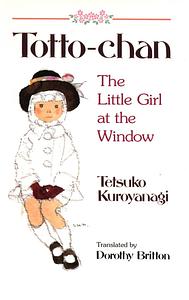Take a photo of a barcode or cover
This was a sweet and thought provoking book told from the perspective of a young girl (I love books with children's perspectives) who goes to an unconventional school in Japan. Each chapter is an anecdote about her experience and I thoroughly enjoyed the writing style and subject matter.
I learned after reading the book that the author is a famous tv personality from Japan and she wrote this book as an homage to the school master she learned so much from. This is a great book to be totally transported.
I learned after reading the book that the author is a famous tv personality from Japan and she wrote this book as an homage to the school master she learned so much from. This is a great book to be totally transported.
Tetsuko Kuroyanagi's "The Little Girl at the Window" is an unmissable treat!
Dorothy Britton has done a fabulous job at translating one of Japan's most beloved works, which I assure you, can be read even by those who are still in middle school. There wasn't a sentence in this book that wasn't impactful and neither did it have any moments to make you contemplate if you should drop it - it was just perfect.
What you should know is that, the happenings in this memoir is only prior to WW-II when tensions were high until attack on Japan became inevitable. Yet this book shifts focus away from the sufferings of war, only to take the readers through joyful experiences of little kids at an unsual school called Tomoe Gakuen which proudly boasted of old railroad cars for classrooms. Through the eyes of Totto-chan, we can take delight in the non conventional school activities her and her friends partook in. Be it having a farmer as a teacher or camping in the assembly hall at night just to see how old railroads are transported off tracks, there is never a dull moment at Tomoe.
But the star of the book is Sosaku Kobayashi-san, the head master of this school with fifty students. Towards the end, author lets us in on the fact that this book is her way of making good on her broken pledge to Kobayashi-san. Sure it was full of happy times that these children lived in, unaware of what was happening beyond their bubble but they weren't completely untouched by moments of sadness. It made this memoir whole lot more emotionally appealing.

(Chihiro Art Museum Azumino.)
It kept me on my toes and I was contantly googling names, places and events all throughout. It makes me so happy that the author decided to give us all updates about her friends from Tomoe Gakuen at the end. It somehow gives closure to the readers who were left wondering what happened to everyone once the war was over their heads. This would make a great Hayao Miyazaki film. I believe I'd frequent this memoir lot many times in the future.
Dorothy Britton has done a fabulous job at translating one of Japan's most beloved works, which I assure you, can be read even by those who are still in middle school. There wasn't a sentence in this book that wasn't impactful and neither did it have any moments to make you contemplate if you should drop it - it was just perfect.
'The tomoe is an ancient comma-shaped symbol, and for his school the headmaster had adopted the traditional emblem consisting of two tomoe - one black and one white--united to form a perfect circle.'
What you should know is that, the happenings in this memoir is only prior to WW-II when tensions were high until attack on Japan became inevitable. Yet this book shifts focus away from the sufferings of war, only to take the readers through joyful experiences of little kids at an unsual school called Tomoe Gakuen which proudly boasted of old railroad cars for classrooms. Through the eyes of Totto-chan, we can take delight in the non conventional school activities her and her friends partook in. Be it having a farmer as a teacher or camping in the assembly hall at night just to see how old railroads are transported off tracks, there is never a dull moment at Tomoe.
'Those were the days when you could still find crayfish in the pond near their house in Tokyo, and the garbage man's cart was pulled by a great big ox.'
But the star of the book is Sosaku Kobayashi-san, the head master of this school with fifty students. Towards the end, author lets us in on the fact that this book is her way of making good on her broken pledge to Kobayashi-san. Sure it was full of happy times that these children lived in, unaware of what was happening beyond their bubble but they weren't completely untouched by moments of sadness. It made this memoir whole lot more emotionally appealing.
(Chihiro Art Museum Azumino.)
It kept me on my toes and I was contantly googling names, places and events all throughout. It makes me so happy that the author decided to give us all updates about her friends from Tomoe Gakuen at the end. It somehow gives closure to the readers who were left wondering what happened to everyone once the war was over their heads. This would make a great Hayao Miyazaki film. I believe I'd frequent this memoir lot many times in the future.
As she started walking away, she was sure she heard his voice behind her, "Totto- chan, we had a lot of fun together, didn't we? I'II never forget you. Never.”
adventurous
emotional
hopeful
informative
inspiring
lighthearted
reflective
relaxing
sad
medium-paced
emotional
hopeful
lighthearted
medium-paced
funny
hopeful
informative
inspiring
lighthearted
fast-paced
I loved this book. I loved all the characters. This book was so amazing, inspiring, and heartbreaking. But I felt so sad for the ending.
Saat membaca buku ini jadi membayangkan seandainya dulu bersekolah di sekolah seperti Tomoe Gakuen.
Saat membaca buku ini jadi membayangkan seandainya dulu bersekolah di sekolah seperti Tomoe Gakuen.
Emang ya, buku kalo dibaca ulang /re-read feelsnya beda.
Pertama kali aku baca buku ini, kurang lebih 1 dekade yg lalu(?). Lupa deh, antara masih SD atau SMP.
Waktu itu asal pinjam dan baca buku punya kakak sepupu, ternyata bagus.
Dan beberapa waktu lalu, ingin sekali baca ulang buku ini. Kebetulan juga dapet kabar kalo buku ini dijadikan "anime movie". And here I am...
Dari beberapa bab di buku ini, ada beberapa part yg berkesan, membuatku tersenyum bahkan tertawa, dan juga membuat mataku basah. Secara keseluruhan, aku sangat suka dengan buku ini.
Akupun juga suka dengan cara mama Totto-Chan menghadapi, bereaksi, mendengarkan cerita atau berbicara dengannya. Termasuk para guru dan juga kepala sekolah kepada murid-murid Tamoe, yang mengajarkan banyak hal.
Ada satu momen dimana kepala sekolah memarahi salah satu wali kelas. Beliau membawa si guru ke tempat yang sepi, dan tidak seorangpun tau (kecuali 2 bocah yang diam-diam menguping). Aku bingung menjelaskan perasaan yg aku rasakan saat membaca ini, tapi rasanya aku suka banget dengan tipe pemimpin /orang yg seperti ini. Memberikan kritik dan saran, tapi tidak di depan banyak orang. Sehingga tidak membuat orang bersangkutan malu.
Lalu ada beberapa kutipan yang sangat aku garis bawahi;
"
Pertama kali aku baca buku ini, kurang lebih 1 dekade yg lalu(?). Lupa deh, antara masih SD atau SMP.
Waktu itu asal pinjam dan baca buku punya kakak sepupu, ternyata bagus.
Dan beberapa waktu lalu, ingin sekali baca ulang buku ini. Kebetulan juga dapet kabar kalo buku ini dijadikan "anime movie". And here I am...
Dari beberapa bab di buku ini, ada beberapa part yg berkesan, membuatku tersenyum bahkan tertawa, dan juga membuat mataku basah. Secara keseluruhan, aku sangat suka dengan buku ini.
Akupun juga suka dengan cara mama Totto-Chan menghadapi, bereaksi, mendengarkan cerita atau berbicara dengannya. Termasuk para guru dan juga kepala sekolah kepada murid-murid Tamoe, yang mengajarkan banyak hal.
Ada satu momen dimana kepala sekolah memarahi salah satu wali kelas. Beliau membawa si guru ke tempat yang sepi, dan tidak seorangpun tau (kecuali 2 bocah yang diam-diam menguping). Aku bingung menjelaskan perasaan yg aku rasakan saat membaca ini, tapi rasanya aku suka banget dengan tipe pemimpin /orang yg seperti ini. Memberikan kritik dan saran, tapi tidak di depan banyak orang. Sehingga tidak membuat orang bersangkutan malu.
Lalu ada beberapa kutipan yang sangat aku garis bawahi;
"
Totto-chan: The Girl at the Window, by Tetsuko Kuroyanagi, translated by Dorothy Britton
Written by Tetsuko Kuroyanagi, a well-known Japanese actress and talk show host, Totto-chan: The Little Girl at the Window was a bestseller when published in Japan in 1981. I knew nothing at all of this book until I picked it up at a free corner library, August 2016. Having worked at the Albany Free School, read Summerhill, earned a Master’s degree in education, and taught for a decade at a Waldorf school, I suppose I should not have been surprised at finding another example of a heart-centered school.
The story is about a first grade girl, Totto-chan, expelled from a mainstream Japanese school. Her mother discovers the Tomoe school, where Totto-chan blossoms. From an “overactive” child calling street musicians to play at her classroom window, Totto-chan is adopted wholeheartedly into a funky school of 50 students in grades 1-6, where classes are held in old train cars, and love is the overriding method.
The book is a memoir Ms. Kuroyanagi’s own experiences, though told in story form. Occasionally the chapters lapse into some more adult explanation of the headmaster’s educational beliefs or the dark historical events of the time, but most of the book proved enthusiastically readable to my almost first grader. To a child of the 21st century, this is a book from a bygone era, where the fact that the children ride the train themselves and don’t have TV is as foreign as the fact that they live as far away from Colorado as earthly possible.
There is something similar in character Chris Mercogliano’s Making It Up As We Go Along: The Story of the Albany Free School. Both books utilize stories to illustrate educational methods. The schools at the center of each book focus on love and freedom. Both schools are small and live on the fringe of acceptable education. While the Albany Free School is the longest living such institution in the United States, the Tomoe school lasted just eight years before being burned to the ground by B29 bombers flattening Tokyo in 1945. There is a great sadness in this loss and the fact that the headmaster Sosaku Kobayashi never managed to start another similar school, dying in 1963. It is a great gift that Ms. Kuroyanagi has written this book as a record of her experiences.
What stands out throughout the book is Mr. Kobayashi’s love for the students. Totto-chan’s “interview” for admission when she first comes to Tomoe consists of Mr. Kobayashi inviting her to tell him anything she wants. She talks for four hours, until she runs out of things to say. Later in the book, when she has lost a favorite purse down the outhouse toilet and is fishing for it through an access door, the headmaster merely asks that she put all the slop she’s fished out back.
This book was such a success in Japan because the implicit suggestion is that rigorous academics count out children like Totto-chan. At the end of the book there is an epilogue to describe what some of the characters did with their lives. Totto-chan and her classmates did very well in their lives, successful by any standard. Unfortunately, the sort of education, even the sort of living that this little girl experienced, without screens and medication, without hovering parents (her mother comes looking for her at some point because it is getting dark, and finds her stuck in a pile of wall plaster), without the fear and violence which march hand-in-hand through every vein of our society, this sort of existence must still exist on the fringes of society while children in mainstream schools lose out on music, art, recess, real food, medicated to their desks and standardized tests. This is the kind of book that offers a glimmer of hope that maybe those corners where education is humanizing will yet hold sway, even if they must live on the edge.
Written by Tetsuko Kuroyanagi, a well-known Japanese actress and talk show host, Totto-chan: The Little Girl at the Window was a bestseller when published in Japan in 1981. I knew nothing at all of this book until I picked it up at a free corner library, August 2016. Having worked at the Albany Free School, read Summerhill, earned a Master’s degree in education, and taught for a decade at a Waldorf school, I suppose I should not have been surprised at finding another example of a heart-centered school.
The story is about a first grade girl, Totto-chan, expelled from a mainstream Japanese school. Her mother discovers the Tomoe school, where Totto-chan blossoms. From an “overactive” child calling street musicians to play at her classroom window, Totto-chan is adopted wholeheartedly into a funky school of 50 students in grades 1-6, where classes are held in old train cars, and love is the overriding method.
The book is a memoir Ms. Kuroyanagi’s own experiences, though told in story form. Occasionally the chapters lapse into some more adult explanation of the headmaster’s educational beliefs or the dark historical events of the time, but most of the book proved enthusiastically readable to my almost first grader. To a child of the 21st century, this is a book from a bygone era, where the fact that the children ride the train themselves and don’t have TV is as foreign as the fact that they live as far away from Colorado as earthly possible.
There is something similar in character Chris Mercogliano’s Making It Up As We Go Along: The Story of the Albany Free School. Both books utilize stories to illustrate educational methods. The schools at the center of each book focus on love and freedom. Both schools are small and live on the fringe of acceptable education. While the Albany Free School is the longest living such institution in the United States, the Tomoe school lasted just eight years before being burned to the ground by B29 bombers flattening Tokyo in 1945. There is a great sadness in this loss and the fact that the headmaster Sosaku Kobayashi never managed to start another similar school, dying in 1963. It is a great gift that Ms. Kuroyanagi has written this book as a record of her experiences.
What stands out throughout the book is Mr. Kobayashi’s love for the students. Totto-chan’s “interview” for admission when she first comes to Tomoe consists of Mr. Kobayashi inviting her to tell him anything she wants. She talks for four hours, until she runs out of things to say. Later in the book, when she has lost a favorite purse down the outhouse toilet and is fishing for it through an access door, the headmaster merely asks that she put all the slop she’s fished out back.
This book was such a success in Japan because the implicit suggestion is that rigorous academics count out children like Totto-chan. At the end of the book there is an epilogue to describe what some of the characters did with their lives. Totto-chan and her classmates did very well in their lives, successful by any standard. Unfortunately, the sort of education, even the sort of living that this little girl experienced, without screens and medication, without hovering parents (her mother comes looking for her at some point because it is getting dark, and finds her stuck in a pile of wall plaster), without the fear and violence which march hand-in-hand through every vein of our society, this sort of existence must still exist on the fringes of society while children in mainstream schools lose out on music, art, recess, real food, medicated to their desks and standardized tests. This is the kind of book that offers a glimmer of hope that maybe those corners where education is humanizing will yet hold sway, even if they must live on the edge.
hopeful
lighthearted
reflective
medium-paced
hopeful
inspiring
lighthearted
reflective
relaxing
medium-paced







